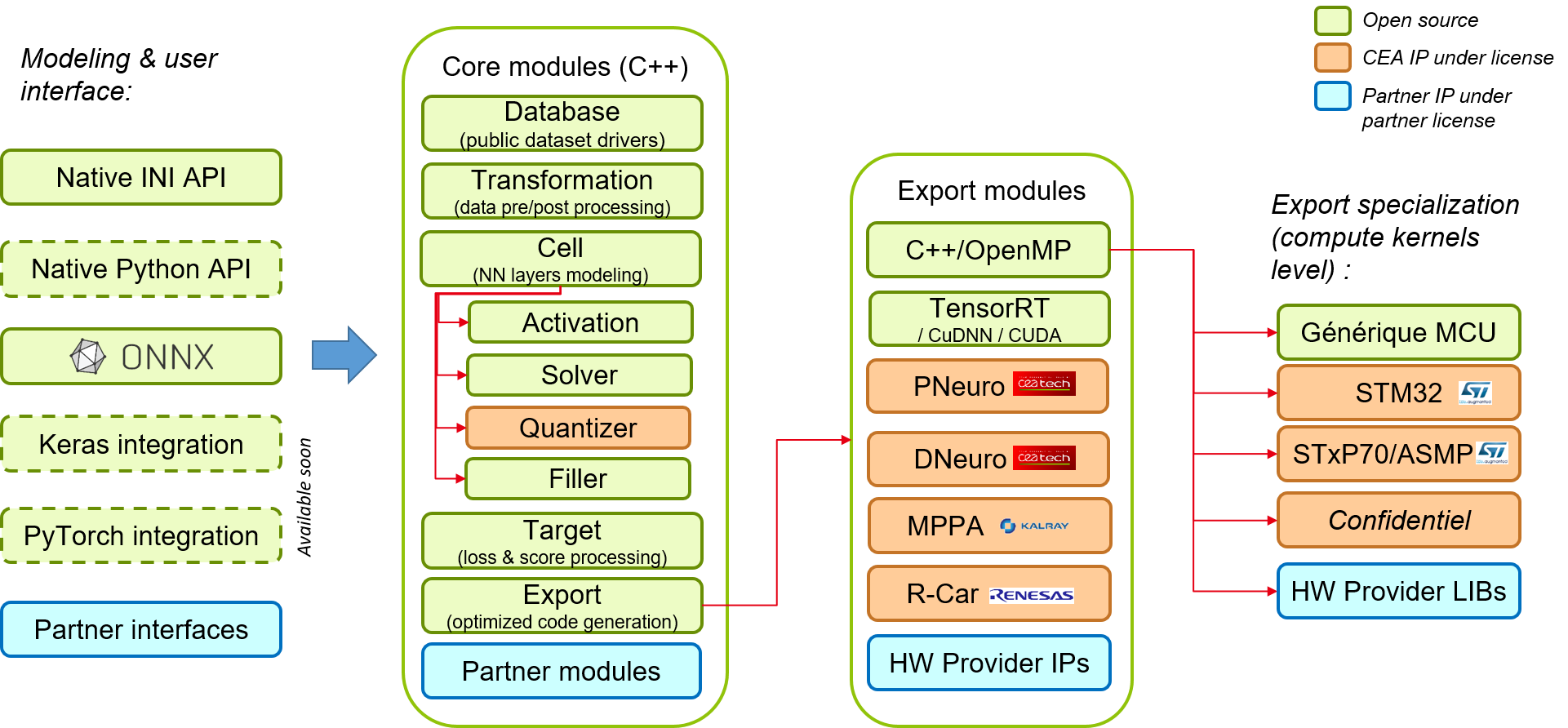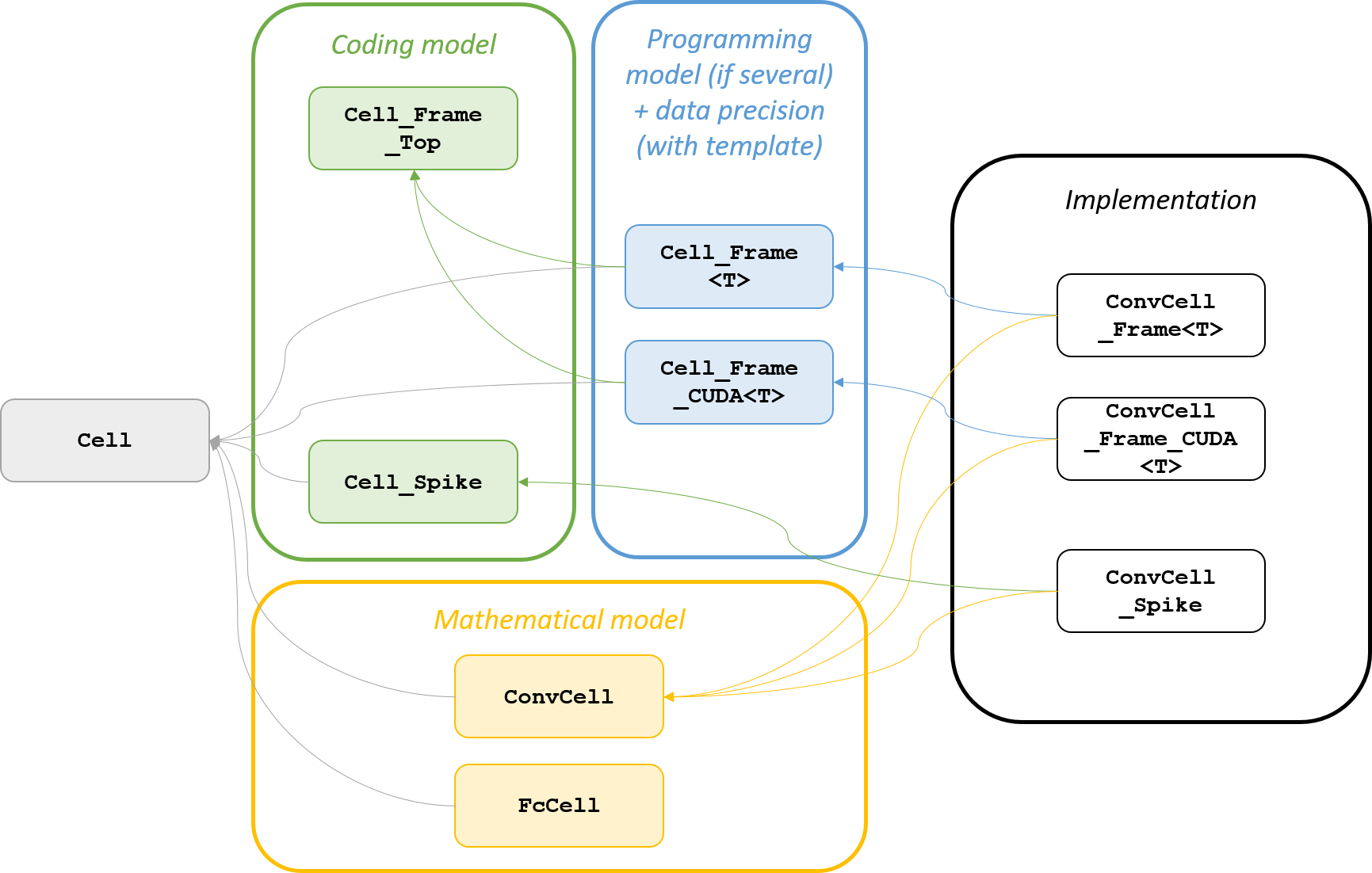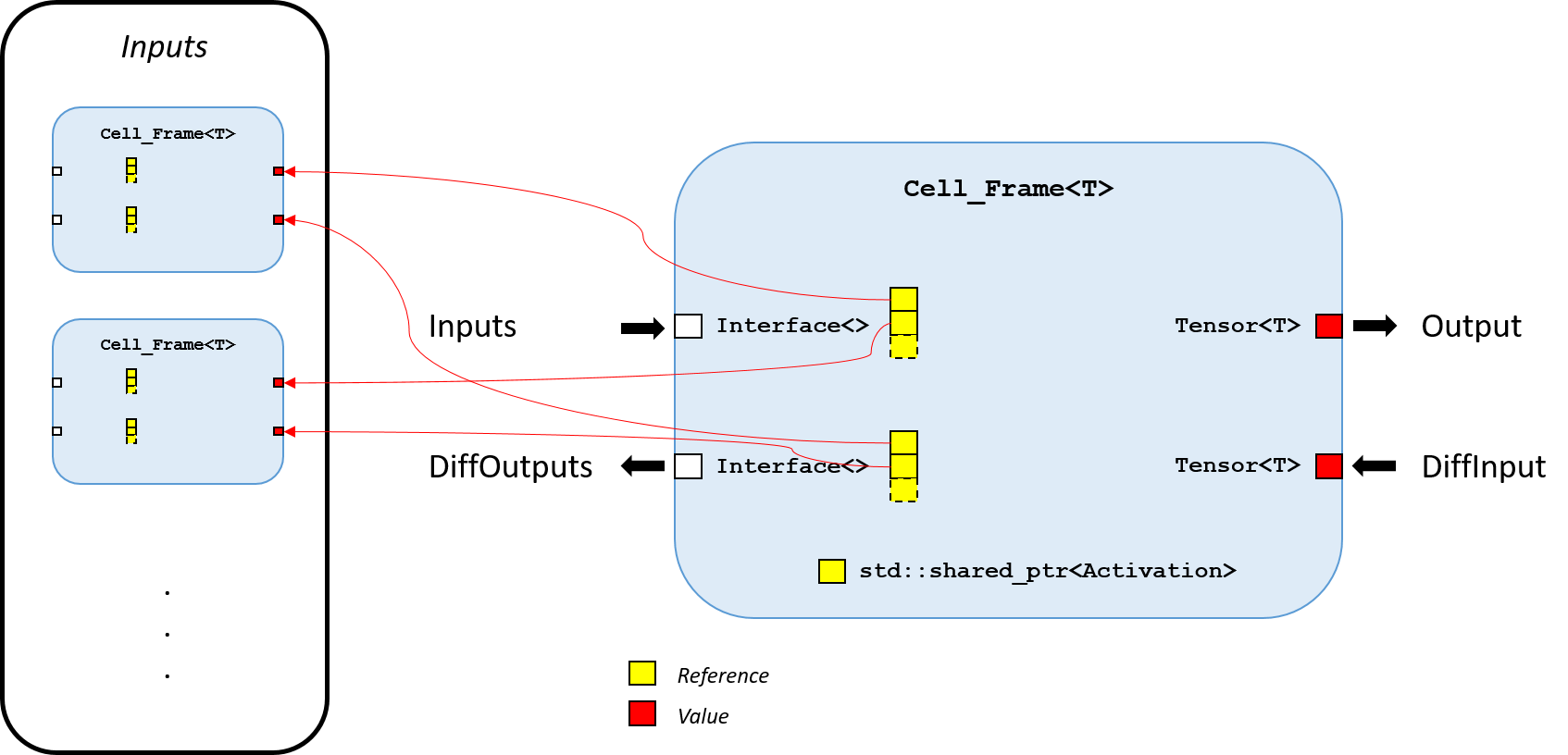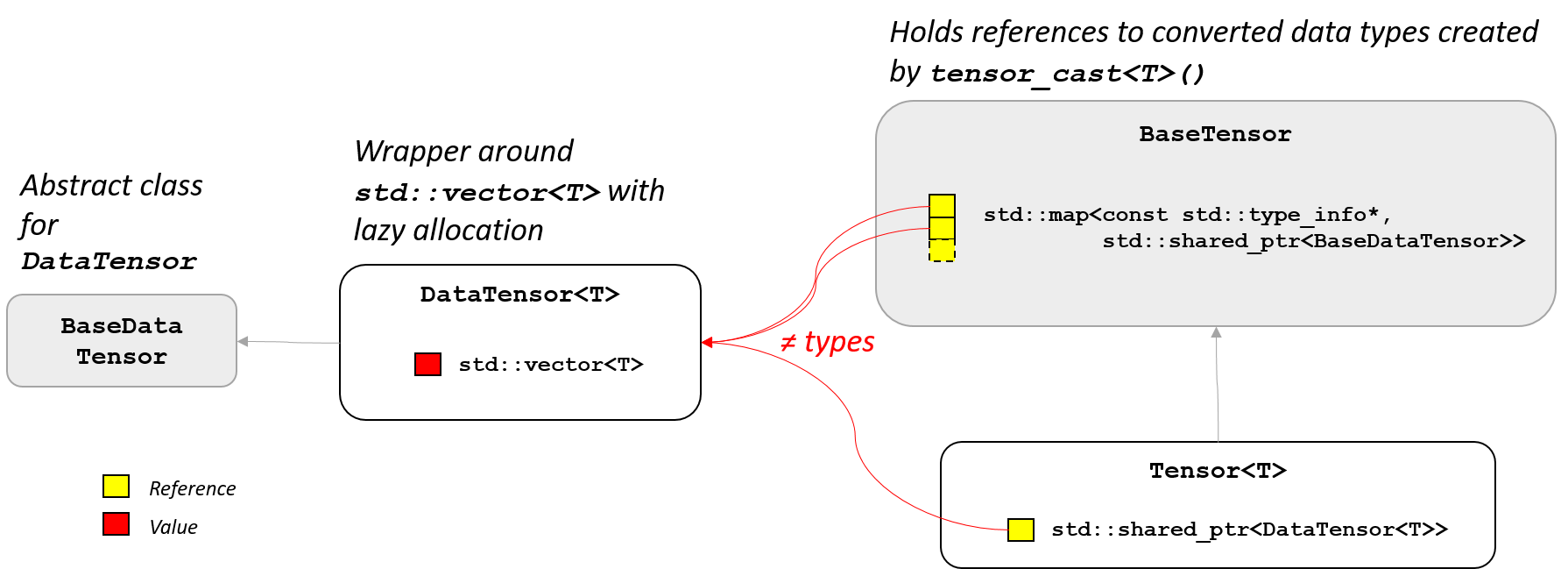Introduction¶
Welcome to the developer documentation. N2D2 is primarily developed in C++11 and CUDA (for the GPU computing kernels). The library used internally for images processing is OpenCV.
N2D2 is structured in module families, each family being defined by a base class,
for example Database, Cell, Export…
In this introduction, we will review the main N2D2 modules structure, which is
summarized in the figure below:

Main N2D2 modules.¶
The Cell modules¶
A Cell defines a layer / operator, constituting a base building block of a
neural network (or more generally a compute graph), like a convolution, a
pooling and so on.
The base Cell class is abstract and does not make any assumption on the
compute model, the data precision and even the coding of the data.
The class hierarchy for Cell is shown in the figure below. While it may
seem a bit complicated, it was designed this way to really separate different
notions:
Mathematical model: the actual mathematical function performed by the
Cell, regardless of the algorithm used for its implementation. For example,ConvCellfor a convolution, orFcCellfor a fully connected layer (or inner product);Coding model: the model used to code the data.
Frameis for standard tensor-based deep learning andSpikeis for neuromorphic spike coding;Programming model: the programming model that will be used for the implementation, meaning either plain C++ (with OpenMP) for CPU or CUDA for GPU. Other programming model, like OpenCL, may be added in the future. When there is only one programming model, the class hierarchy can be simplified like for
Cell_Spike. The Programming model class can be templated to handle different data precision. For theCell_Frame<T>andCell_Frame_CUDA<T>classes,half,floatanddoubleprecision are supported, but may not be implemented for every model (it is not mandatory to provide implementation for every possible precision);Implementation: the actual implementation of the Mathematical model, using the inherited Coding model and Programming model. The implementation may use different algorithm to obtain the same Mathematical model, like direct, GEMM or FFT algorithms for the convolution.

Cell modules class hierarchy.¶
Cell class¶
The base Cell class only handles the topological information: the inputs
and outputs dimensions and virtual methods to connect the cells, among other.
The main methods are listed here:
-
inline const std::string &getName() const¶
Returns cell name.
-
virtual const char *getType() const = 0¶
Returns cell type.
-
inline const std::vector<size_t> &getInputsDims() const¶
-
inline const std::vector<size_t> &getOutputsDims() const¶
In order to create a computing graph, or neural network, cells can be connected
together thanks to the addInput method. An Cell can be connected to
another Cell or to a StimuliProvider, which constitute an entry point
for the data. It is up to the implementation to allow or not multiple inputs.
The initialize virtual member initializes the state of the Cell in the
implementation (initialization may be different depending on the coding or
programming model).
-
virtual void addInput(StimuliProvider &sp, unsigned int channel, unsigned int x0, unsigned int y0, unsigned int width, unsigned int height, const Tensor<bool> &mapping = Tensor<bool>()) = 0¶
Connect an input filter from the environment to the cell.
- Parameters:
sp – N2D2 StimuliProvider object reference
channel – Channel number in the environment
x0 – Left offset
y0 – Top offset
width – Width
height – Height
mapping – Connection between the environment map and the cell output maps (size of the vector = number of output maps in the cell)
-
virtual void addInput(StimuliProvider &sp, unsigned int x0 = 0, unsigned int y0 = 0, unsigned int width = 0, unsigned int height = 0, const Tensor<bool> &mapping = Tensor<bool>()) = 0¶
Connect an input map from the environment to the cell.
- Parameters:
sp – N2D2 StimuliProvider object reference
x0 – Left offset
y0 – Top offset
width – Width
height – Height
mapping – Connection between the environment map filters and the cell output maps (size of the matrix = number of output maps in the cell [cols] x number of filters in the environment map [rows])
-
virtual void addInput(Cell *cell, const Tensor<bool> &mapping = Tensor<bool>()) = 0¶
Connect an input cell to the cell.
- Parameters:
cell – Pointer to the input cell
mapping – Connection between the input cell output maps (input channels) and the cell output maps (size of the matrix = number of output maps in the cell [cols] x number of input cell output maps (input channels) [rows])
-
virtual void addInput(Cell *cell, unsigned int x0, unsigned int y0, unsigned int width = 0, unsigned int height = 0) = 0¶
Connect an input cell to the cell.
- Parameters:
cell – Pointer to the input cell
x0 – Left offset
y0 – Top offset
width – Width
height – Height
-
inline virtual void initialize()¶
Initialize the state of the cell (e.g. weights random initialization)
Cell_Frame_Top class¶
The Cell_Frame_Top is a purely abstract class, which does not inherit from
the Cell class. It provides
all the actual interface for a given Coding model. For the Frame coding
model, the input/output data is a Nd-tensor. This coding model is also
“bi-directional”, as it supports differentiation, thus its interface comprise
a forward data path and backward data path for the gradient. It is however not
mandatory for the implementation to handle the backward path, for non-differentiable
cells for example.
The main interfaces provided by Cell_Frame_Top are listed below:
-
virtual void propagate(bool inference = false) = 0¶
-
virtual void backPropagate() = 0¶
-
virtual void update() = 0¶
This class also handles the Activation and contains the shared pointer to
the Activation object to use.
-
inline const std::shared_ptr<Activation> &getActivation() const¶
Cell_Frame<T> class¶
The Cell_Frame<T> inherits from Cell and Cell_Frame_Top. It contains
the output tensors and input tensor references.
Cell_Frame<T> should not provide more members than Cell_Frame_Top already does.

Cell_Frame<T> interface.¶
ConvCell class¶
The ConvCell class (or any other model) provides additional interfaces to
the base Cell class that it inherits, specific to the Mathematical model
it represents, regardless of the Coding model. For a convolution for example,
getter and setter members are provided for the weights, but also references to
Filler and Solver for the weights. Some facilities may be specific to
a particular coding model. The data structure (tensor) containing the weights
is however not defined in this class, but in the implementation
(ConvCell_Frame), because it can depend on the programming model and data
precision.
The main members (for ConvCell) are:
-
virtual void getWeight(unsigned int output, unsigned int channel, BaseTensor &value) const = 0¶
-
virtual void getBias(unsigned int output, BaseTensor &value) const = 0¶
-
virtual void setWeight(unsigned int output, unsigned int channel, const BaseTensor &value) = 0¶
-
virtual void setBias(unsigned int output, const BaseTensor &value) = 0¶
ConvCell_Frame<T> class¶
The ConvCell_Frame<T> is the final class implementing the convolution
Mathematical model with the tensor-based Frame Coding model on standard
C++ for CPU Programming model. It is only an implementation class, which
therefore does not provide any new members.
The Tensor<T> class¶
The Tensor<T> class is the base data structure in N2D2, a Nd-tensor. In
N2D2, a tensor has the following properties:
Its data is guaranteed to be continuous. It therefore does not handle arbitrary strides without actual data reorganization. While this property may appear restricting, it is an assumed design choice to simplify the implementation of the many possible coding and programming models;
It holds a reference to the data, meaning no data is actually copied in a tensor assignment and the new tensor will point to the same data. To perform an actual copy, the
clone()method should be used;It is explicitly typed, meaning that the data type is part of the tensor type, as a template parameter. When the type does not need to be known or can be arbitrary, a reference to the
BaseTensorbase class should be used. Conversion from one tensor type (or from aBaseTensorreference) to another can be performed with thetensor_cast<T>()function;Down to zero overhead type conversion. Memory is only allocated once for a given type conversion during the lifetime of the tensor. Type conversion can be made without any data copy-conversion, with the
tensor_cast_nocopy<T>()function, when it is known that a previous conversion is still valid, thus incurring zero overhead.
The Tensor<T> implementation classes hierarchy is shown in the figure below.

Tensor<T> implementation classes hierarchy.¶